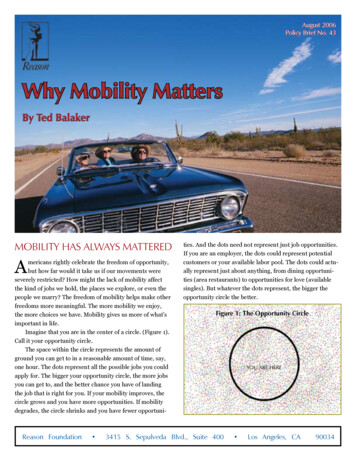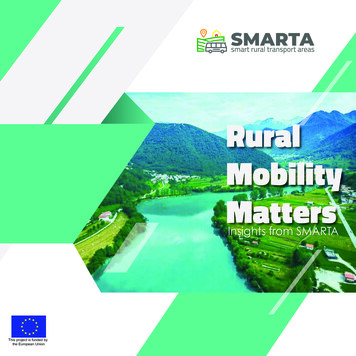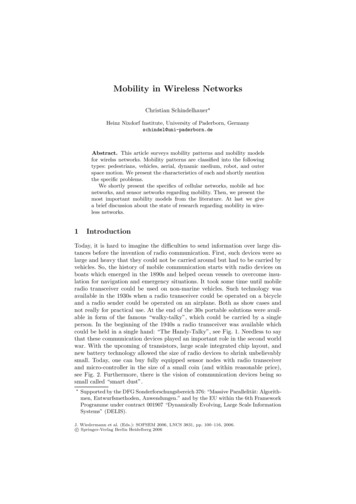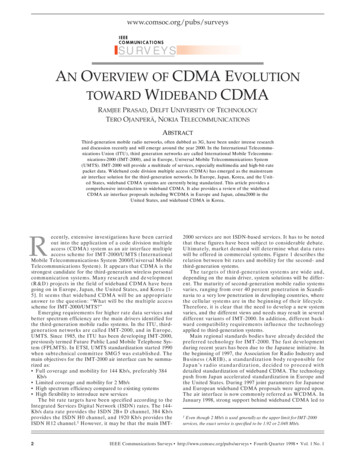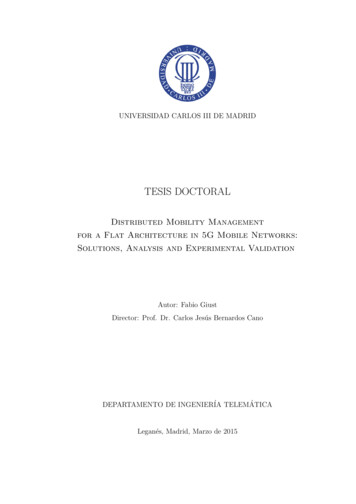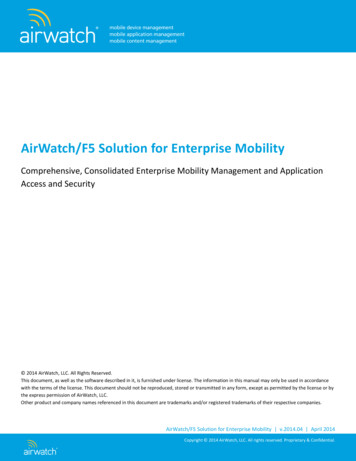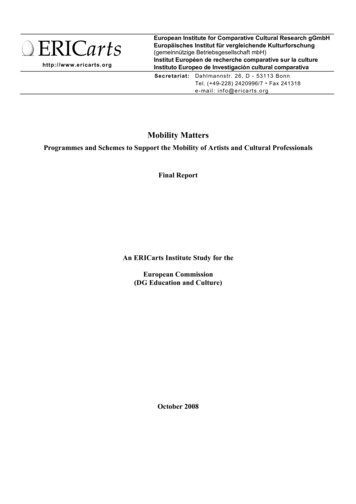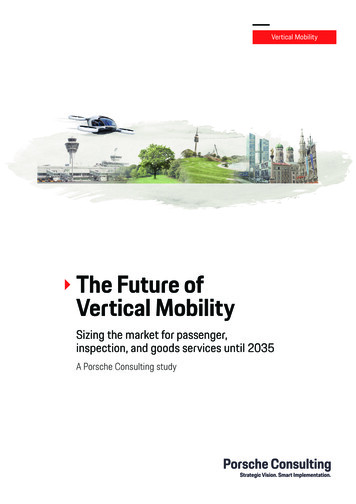
Transcription
Vertical MobilityThe Future ofVertical MobilitySizing the market for passenger,inspection, and goods services until 2035A Porsche Consulting study
Note to the readerFlying promises a very special and seemingly boundlessform of freedom. People have always dreamt of taking off andmoving through the air. Leonardo da Vinci (1452-1519), theItalian artist, engineer, and natural philosopher, studied birds forideas on how to design flying machines. His results used muscle power for propulsion.Vertical mobility, which includes vertical take-off and landing(VTOL) abilities, played a role even in da Vinci’s time. Around1490 he sketched an aircraft with an aerial screw, which is aprecursor to today’s helicopters. He called his invention the helixpteron, or “spiraling wing”. The Chinese had already applied thisprinciple of upward motion some 2,500 years before to a toy inthe form of a vertically ascending top.Da Vinci was not able to put his invention into practice. Helacked lightweight and stable materials. Nor was a sufficientlypowerful drive system available at the time. Many designers subsequently attempted to produce rotary-wing aircraft.It was not until much later, in 1901, that the first helicopterrose into the air above Berlin. Today, more than a century later,rotorcraft machines are acquiring new significance. As smallscale, versatile drones, they could play an important role as linksbetween different modes of connected, future-oriented transportation–whether as four-seat aerial taxis, delivery vehicles, orfor inspection purposes.Porsche Consulting Vertical MobilityWhy are small aircraft of this type attracting serious attention?The aviation industry has undergone enormous development.Wide-body planes can carry as many as 850 passengers. Flying throughout the world is a routine practice. But only noware future-oriented technologies making it possible for shortdistance connections to utilize the airspace, above large citiesin particular.Environmentally friendly electric propulsion systems, highperformance batteries with extremely short charging times,minimal spatial requirements for taking off and landing, highspeed computers, and big data have laid the foundation forrevolutionary new applications. We are entering an era in whicheveryone will be able to operate aircraft. Even without a pilot’slicense. Because drones can be remote-controlled. In their role aspilots, passengers need do little more than select a destination.All new developments first need to be accepted, of course.Reservations and concerns are natural human reactions tomajor changes. Aware of these responses, the authors of thestudy “The Future of Vertical Mobility” have addressed them.Yet they are also certain that superior technology will encompass the necessary safety and security features to convincinglyeliminate reservations and concerns. The study therefore takesa thorough and comprehensive approach in its analysis of thefeasibility of vertical mobility.02
At a GlanceVertical mobility offers mankind a serious shot at turning the dream of flying into a reality foreveryone, and inspection, goods, and passenger services have the potential to become a global market worth 74 billion by 2035.After first field tests, we expect electric passenger drones oreVTOL aircraft (short for electric vertical take-off and landing)to start providing commercial mobility services in 2025. In justseven years from now, the first drone air taxis will lift off, primarily in big cities around the world. They will mostly connectairports and city centers, offering short transfer flights for business travelers. Within one decade after that, by 2035, dronescould already be servicing their own elaborate passenger network with about 23,000 aircraft plying major routes and creating a market worth 32 billion (fig. 1).Passenger dronesStarting in 2025Electric VTOL in 2035Passenger market 2035*Air taxis23,000 units32 billion* Intracity and city-to-cityFigure 1. Air taxis for everyone: the timeframe for commercial passenger drones.If this vision is to become reality, the four key elements of theeVTOL ecosystem have to be debated, designed, and developed in the coming years: the underlying technology, theregulatory framework, social acceptance, and the necessaryinfrastructure. Even though much points to a future in whichvertical mobility will elevate personal transportation to the thirddimension, in its current state it is a venture fraught with significant risks.Vertical mobility will only be one piece in the larger puzzle ofurban transport because it has a limited range of applicationsand can typically beat other modes of transportation, such astaxis, at distances of 20 kilometers or more.1 This minimumrange is almost twice as long as the average urban journey of11 kilometers (1). Still, vertical mobility holds promise in relieving some pressure from particularly congested urban hot spots– but only some. If one tried to solve all traffic problems on theground by moving into the air, the myriad take-off and landingspots would become the new choke points.Graphic: Porsche Consultingcan take off and land anywhere are not a realistic scenario forthe mid-term future. Even a megacity with five to ten millioninhabitants will have no more than 1,000 passenger drones inoperation by 2035. Passenger drones will for some time remaina hub-to-hub travel option that depends on other modes oftransportation, rather than an end-to-end solution.Looking at unmanned eVTOL aircraft, the market for inspectiondrones will grow to 34 billion and 21.5 million active units by2035, complemented by the market for goods-and-deliverydrones at 4 billion and 125,000 units. Inspection drones arein use today, and goods drones are already being tested aroundthe world. The market for supporting services around inspection, goods, and passenger drones will reach another 4 billionby 2035.To be sure, the time for vertical mobility has come. The onlyquestions are how big the market will be and how fast it willevolve. This is the focus of the following report.There is no need to worry that the skies will be clogged withdrones, however, since passenger drones and flying cars that1 This report differentiates between intracity and city-to-city applications since various travel distances require different technical concepts.Porsche Consulting Vertical Mobility03
PrefaceD istance:30Air taxiAirport to the citykmasthsflierowceMunichΏΏ Flight time: 10 minutesΏΏ Price: 100 / 123ΏΏ Travel speed: 200 km/hMunich airportMarienplatz, Munich (city center)Figure 2. Air taxis are available for fast connections between airports and cities: in Munich,for example, the fastest connection would take only ten minutes.Graphic: Porsche ConsultingThis report provides a strategic overview of a more detailed analysis and aims to accomplishthree goals:01 Add a fact-based foundation to the hype around verticalmobility, which inspires the public’s imagination as the firstpassenger drones are tested and details of the Uber Elevate airtaxi service emerge (2).02 Offer pragmatic and neutral analysis following our mis-sion to “think strategically and act pragmatically.”03 Share our findings with the ecosystem of companiesWe want to answer three key questions raised bythe new mobility landscape:ΏΏ What is the market potential in 2035?ΏΏ What are basic, conservative, and progressivemarket scenarios to get there?ΏΏ What are the opportunities for customers,cities, manufacturers, operators, andand startups, city governments, and the public, as well asaerospace and other regulatory entities.investors?Porsche Consulting will do its part to continuouslyobserve the vertical mobility space.The following pages will identify and assess the drivers andbarriers defining the vertical mobility ecosystem and describethe most likely development paths and scenarios. It representsa market-based model grounded in today’s mobility patternsand current market predictions. We focused on electricallypropelled aircraft and excluded military applications.The authors want to thank the team, external partners, andproject sponsors who made this report possible. Specialthanks go to our key partner, the German Aerospace Center(Deutsches Zentrum für Luft- und Raumfahrt, DLR).This report brings together the expertise and input of PorscheConsulting and 62 internationally renowned experts from thedomains of aerospace, technology, and automotive.Porsche Consulting Vertical MobilityWe look forward to hearing your thoughts, comments, andquestions to keep the debate around vertical mobility going.04
Table of ContentsAt a Glance03Preface041 The Ecosystem062 The Benefits of Vertical Mobility133 The Timeline: A Journey to Zero-emission Flying Taxis164 Sizing Up the Market195 Seizing the Opportunity of Vertical Mobility29Appendix32Authors, Partners, and Sponsors34Porsche Consulting Vertical Mobility05
1 The EcosystemTaking flight has always fueled human imagination and fascinated artists as well as tinkerers,but only recently have technological innovations–from electric propulsion systems to artificialintelligence and communications networks–opened a window into what will be possible in thenear future.Vertical mobility for everyone is no longer a fantasy or wishful thinking but is making steady progress in research labsand companies around the world. It is becoming a piece inthe ever-changing puzzle called mobility. Novel ride-hailingand ride-sharing services on the ground have demonstratedthat there are new ways to transport goods and people moreefficiently and more economically. We need to take a moredetailed look at vertical mobility and its proper role in an integrated and seamless mobility ecosystem to better understand three things: the utility for consumers, the challengesahead for regulatory authorities, and the market opportunitiesfor investors and enterprises.Vertical mobility will become an integral part of overall urbanmobility if it is connected with first- and last-mile modes oftransport, as illustrated in figure 3. Passenger drones can playan important role here because they are fast and available ondemand. They are an attractive and competitive way to coverdistances of 20 kilometers or more since they require relatively few infrastructure investments and can service secondary and tertiary routes. Vertical mobility is also a fast escapefrom clogged routes.Figure 3. Pieces of an integrated puzzle: air taxis can make a significant contribution to urban transport networks.Porsche Consulting Vertical MobilityVertical mobilityPublic transportTaxi and carSoft modeGraphic: Porsche Consulting06
We analyzed four segments of vertical mobility: inspection,goods, and passenger drones as well as drone-related services. Unmanned inspection drones help with monitoringand surveying infrastructure or covering events, while goodsdrones deliver time-critical wares. Passenger drones satisfyintracity and longer city-to-city transportation needs. Thefourth segment across these three markets is comprised ofvarious supporting services for drones. Air traffic management (ATM) for manned and unmanned drones alike is a keyfoundation for making the mobility ecosystem of the futurereliable, safe, and economically viable.We have identified 26 relevant vertical mobility services(fig. 4) and more than 70 detailed sub-services. The mainpurpose of inspection drones is to gather data, while goodsdrones transport goods and deliver parcels. As the nameimplies, passenger drones are designed to transport privatepassengers and offer mobility services to the broader public.Finally, supporting services assist and enable all three majorsegments, from operations and maintenance to charging,insurance, and financing.Vertical mobility ΏΏΏΏΏΏΏΏHobby dronesMedia and entertainmentPrecision agriculture, farming, and forestryInspection and monitoringΏΏΏΏΏΏΏΏAd-hoc communication networkSurveying and mappingLearning, training, and gathering scientific dataSecurity, law enforcement, and people searchΏΏ Cultivation and fertilizationΏΏ Maintenance and air handlingΏΏ Last-mile express deliveryΏΏ Cargo transportationΏΏ Delivery network extension (to remote areas)ΏΏ Emergency transport (medicine and organs)ΏΏ Personal eVTOL aircraft ownershipΏΏ eVTOL aircraft rentalΏΏ On-demand eVTOL air taxi incl. sightseeingΏΏ eVTOL air busΏΏ eVTOL rescue operationsΏΏΏΏΏΏΏΏΏΏ Maintenance, repair, and overhaul (MRO)ΏΏ Vertiports-/stops operation, charging, and parkingΏΏ Insurance and financingDevelopment and production of eVTOLsCertification serviceAir traffic management servicesDrone defenseFigure 4. Four clusters with 26 services: the vertical mobility services at a glance.Porsche Consulting Vertical MobilityGraphic: Porsche Consulting07
While we analyzed all four service clusters in detail and whileeach service cluster presents its own opportunities and challenges, this report will mainly focus on the passenger segment. Nevertheless, aspects such as market data that arerelevant for the overall eVTOL ecosystem will be addressed ina comprehensive fashion.For vertical mobility to become a reality, the ecosystem needsto satisfy requirements across four areas that will otherwisepose barriers to adoption (fig. 5). First, there are the techni-cal requirements for the aircraft system itself, including propulsion. Equally important are requirements in the realm ofcertification and law in order to approve, operate, and properly maintain these novel aircraft. Third, there is the crucialquestion of social acceptance when it comes to noise, safety,and the security of users and city residents alike. Both constituencies will determine mass suitability. Infrastructure isthe final important component, as this mode of transportation requires a network of take-off and landing sites as well asresources for air traffic control, charging, and parking aircraft.Vertical mobility ecosystemAircraftsystemCertificationand lawSocialacceptanceFigure 5. From drones to laws and landing pads: the four key realms of the vertical mobility ecosystem.Porsche Consulting Vertical MobilityInfrastructureGraphic: Porsche Consulting08
Aircraft systemThe design of the aircraft system is critical, and companiesin this field are experimenting with several aerodynamicconcepts. We can distinguish between three major systems (fig. 6). “Multirotor” systems, such as camera dronesor aircraft by the German startup Volocopter, distribute multiple motors around the periphery of the drone to providelift. “Lift-and-cruise” concepts, such as the Aurora eVTOL,combine rotors for lift and fixed wings for forward flight.Other market entrants, such as Lilium’s eVTOL concept, relyon “tilt-x” designs in which wings, rotors, and ducts can betilted. Developing and refining the right aerodynamic concept is a key determining factor for making vertical mobility a reality. Each system has its own pros and cons whenit comes to time to market, travel speed, ideal routes, efficiency, and potential market size.Simplified aerodynamic vertical mobility conceptsSingle phaseMULTIROTORliftDual phaseLIFT AND CRUISEcombinationTransition phaseTILT-Xtilt-wing, tilt-rotor, tilt-ductTime to marketFastest certificationSlower certificationSlowest certificationTravel speed(indicative) 70–120 km/h 150–200 km/h 150–300 km/hRoutesSelectedAllAllPotential 70% of intracity0% of city-to-city100% of intracity100% of city-to-city100% of intracity100% of city-to-cityFigure 6. Faster and further: the three basic aerodynamic concepts for drones, each with pros and cons.Multirotor, as the name implies, is a rotorcraft with two ormore motors, often arranged in a ring around or atop thecabin. Flight control is accomplished by varying the speedof the individual rotors. Multirotor systems have the twinadvantage of being fairly simple and offering safety throughPorsche Consulting Vertical MobilityGraphic: Porsche Consultingredundancy. On the downside, they are hampered by lowertravel speed as well as limitations in weight and range dueto significantly lower efficiency. Initial multirotor systems,however, have a low risk profile and will help define futurestandards in a step-by-step process.09
eVTOL comparedto a helicopterThe second type of aircraft system iscomprised of various hybrid models, allwith separate drive trains for the liftand-cruise flight phases. The hybridmodel allows them to take advantageof the respective properties of fixedwing and rotor aircraft. Wings give themlonger range, while rotors enable themto vertically take off and land moreefficiently and maintain a higher airspeed. The basic technologies of bothelements are already available, and theoverall complexity of hybrid models isin the middle range, depending on aparticular system’s design. Next-generation hybrid drones can be considered the second phase in eVTOL aircraftdevelopment as they offer increasedspeed and efficiency. They provide moretime savings and lower operationalcosts, two key drivers for commercialsuccess in comparison to other modesof transportation.And finally, there are tilt-x conceptswith wings and rotors or ducts, all ofwhich can be tilted. Since they have rotating components that need to reliablyand safely handle the transition fromthe lift to the cruise phase, the complexity of tilt-x systems is significantlyhigher. By design, tilting wings, tiltingrotors, or tilting ducts carry a higher riskof a single point of failure. As such, theunderlying technology cannot currentlybe considered mature enough to handle passenger transport under criticalweather conditions and requires furtherdevelopment to satisfy safety requirements. At the same time, Tilt-x aircraftcan cover long distances at high speedand therefore have clear potential formobility services.Regardless of the particular system,eVTOL aircraft will be an improvement.Even in this technological day and age,vertical mobility has remained the exclusive domain of the wealthy. Helicopters are not only expensive but alsonoisy and unsafe compared to othermodes of transportation. It is also notavailable to the average consumer asan on-demand option. Compared to atraditional helicopter, an electric passenger drone is by orders of magnitudequieter, more reliable, safer, and less expensive (fig. 7).Batteries are the key component of anypassenger drone system, with energydensity acting as both the biggest constraint and most important driver fortheir future development.4xquieter15xhigher reliabilityrealibility2xsafer10xless expensiveFigure 7. Quiet, reliable, safe, and inexpensive:the main advantages of eVTOL over conventionalhelicopters.Graphic: Porsche ConsultingPorsche Consulting Vertical Mobility10
Certification and lawDevelopmentorganization approvalStarting and landinginfrastructure approvaleVTOL censeProductionorganization tion tionFigure 8. Safety first: overview of certification requirements for drones.We expect commercial passenger transport to remain a highly regulated market that will remain under the guidance of thetwo globally preeminent regulatory agencies: the FAA in theUS and EASA in Europe. Looking at the regulatory and legal requirements, one can differentiate between certification of theaircraft development organization, the aircraft itself, the aircraftproduction, the operations, the service, and the pilot license(fig. 8). The system–whether for a helicopter or another typeof aircraft–determines which regulations currently apply. Forinstance, the European standards for small rotorcraft or lightsport airplanes (e.g., CS-23, CS-27, or CS-LSA) will be usedto certify drones for testing; the equivalent organizational standards are Part 21J&G, 145, M, and Part OPS (see appendix).However they will not be directly applicable for commercialeVTOL certifications.Existent certification standards for inspection and goodsdrones as well as active aviation standards can serve as thebasis for certifying passenger drones. We expect these different certification standards to be a starting point for developing and certifying the various aerodynamic concepts shown.Authorities are ready for talks to develop new certificationPorsche Consulting Vertical MobilityGraphic: Porsche Consultingstandards and provide areas in which to test them. There arealso enough local opportunities around the world to test andcertify new drones. It is worth keeping in mind that certification in the aviation world is usually an incremental, step-bystep process–and for good reason. Starting with existent andstable systems, incremental certification will address distributed electric propulsion (DEP) and, later, “sense-and-avoid”technologies and device autonomy.Further legal issues revolve around airspace and traffic management. How will eVTOL aircraft deal with various weatherconditions and how will they sense and avoid other aircraft?Will they use centralized or decentralized communicationchannels? How will the airspace of tomorrow be structured toaccommodate regular aviation and drones? One of the driversin this regard will be the safety of traditional aircraft, as thenumber of inspection and goods drones will rise into the millions. Today, aircraft safety is already an important topic, aswitnessed by almost daily reports of drone encounters. Thisprocess will also fuel an ongoing debate over the safety risksand potential misuse of such systems for criminal or terroristpurposes.11
Social acceptanceInfrastructureGetting the public on board to accept and use eVTOL aircraftwill depend on solving several key issues around safety andsecurity concerns, the potential for visual and noise pollution as well as proving that everyone will benefit from thesesystems being integrated into city mobility–not just thewealthy, as with today’s private helicopters.The crucial component in the success of vertical mobility is theinfrastructure to take off, land, charge, and service a drone aswell as park it in wait for passengers. While there is no shortage of airspace, interfacing with existent transportation is key.Electric VTOL aircraft will only become a useful component oftomorrow’s mobility if they are well and thoughtfully integratedinto the overall transport network of a city. From their locationand number to their size, eVTOL landing sites, or vertiports, area determining factor for the ecosystem. A city needs to havesufficient sites for take-off and landing as well as charging, inaddition to the necessary resources to operationalize air traffic control. Finally, urban eVTOL infrastructure has to strike anacceptable balance between benefits and disturbances, suchas defining and zoning the proper use of rooftops.Experts expect the targeted noise profile of a drone to beabout 65 dBA at 300 feet flight altitude, which registersat one-fourth the noise emitted by a helicopter. The actualvalue will, of course, depend on ambient noise, distance froma drone, its noise characteristics, and maximum noise level.The overarching goal here is to weigh the personal benefitsagainst mass suitability and decide how to best reconcilethe increased comfort of travel and transport with the largercultural change wrought by passenger drones. The public’sperceptions and opinions about vertical mobility vary fromcontinent to continent, from country to country, and fromcity to city, covering everything from fear and skepticism tooutright enthusiasm.We will see the first implementations in locations that aremore open to testing new technology and have quick decision-making processes in place, such as Singapore, Dubai,and China. Their first implementations and resulting lessonswill shape the perception of safety and security concernsand offer ideas for dealing with visual and noise pollution.Porsche Consulting Vertical MobilityMany cities already have heliports and therefore possess thenecessary infrastructure for landing sites. In the first phase, justfive heliports will suffice to create attractive routes. In the nextphase, selected geographies will have up to 40 vertiports asrelatively small take-off and landing sites specifically designedfor passenger drones. In the final phase, megacities with a population of five to ten million or more will have up to 100 suchsites to provide good service coverage.Infrastructure growth will be driven by the initial build-outphase and the ensuing stages of expansion and elaboration,when an increasing number of vertiports service a growingbase of passenger drones. Other components that need to bebuilt are standardized and efficient, such as fast-charging stations and systems for air traffic control (ATC) communications.12
2 The Benefits of Vertical MobilityVertical mobility has the potential to create wide-ranging social benefits by addressingall-too-familiar transportation bottlenecks.VVVInnovativemobility modeFast transportation 20 km2nd and 3rd tierconnectionsFlexible and easyto configureFigure 9. Winning on time, space, and cost: passenger drones will be an integral part of future urban mobility.Sitting in traffic is a global phenomenon that comes withserious negative consequences in terms of time wasted,increased fuel consumption, higher emissions, and loss ofproperty and human life. The infrastructure provided bythe world’s cities to channel the ever-growing traffic flowshas in many cases reached its limit or is about to, often dueto a lack of funding, available space, or both. It has simplybecome too costly and complicated to add new roads andhighways, and more roadways also have a negative impacton residents’ quality of life.Increasing urban populations therefore face the prospect ofspending more and more time en route. By most recent estimates, the average inhabitant of Los Angeles loses approximately 102 hours a year sitting in traffic jams, followed byMoscow and New York with 91 hours, and São Paulo with86 hours. Munich is the German city where drivers spendthe most time in stop-and-go traffic, coming in at 51 hoursPorsche Consulting Vertical MobilityLow infrastructure costsGraphic: Porsche Consultingannually. Overall, German drivers incurred per capita traffic-related losses of 1,770 in 2017 alone (3). Despite thisworsening congestion on the ground, cities have lost nothing of their attraction. The U.N. estimates that by 2050, 70to 80 percent of the world’s population will be urbanized,bringing with it new challenges and opportunities for moreefficient and sustainable mobility solutions (4). Some ofthem include leaving the traffic jams behind and literally lifting off with vertical mobility.As an integrated part of future urban mobility, passengerdrones offer significant advantages (fig. 9). They are aninnovative, quick transportation mode that requires lowinfrastructure investments because “air roads” are almostcost-free and lack traditional limiting factors such as intersections. Drone rides provide extra flexibility because theyare easy to configure and adopt second- and third-tier connections in a city.13
Customer journey on-demand eVTOL air taxiAir mobilityBoarding atvertiporteVTOLflightDe-boardingat vertiport4561237Choice ofmobility modeOrder offly-rideTransport tovertiportTransport tsΏΏ No end-to-end mobility – transfer between other mobility modes necessaryΏΏ Infrastructure limitations (starting and landing)ΏΏ Complementary mobility service onlyFigure 10. From click to lift-off: eVTOL mobility services offer an end-to-end journey that combines ground with air transport.Saving time on transportation–or avoiding traffic jams on theground–is the basic precondition for this market to develop.At the same time, the hub-to-hub architecture requires passengers to transfer, which can be time consuming. In mostcases, vertical mobility will only win against other modes oftransportation when passengers can save at least 20 percent in total travel time, notwithstanding transfers.Graphic: Porsche Consultingtake customers from quickly putting together their itinerary,ordering their fly-ride, catching ground transport to a vertiport, boarding the eVTOL flight, and, once landed, having aride-hailing service waiting to cover the last mile. Navigating this multipart journey also allows for the more efficientuse of existing bottlenecks on the ground by unburdeningcongested infrastructure.A seamless experience will be another key to the successof passenger mobility service offerings (fig. 10). Customers already have a wide choice of transportation modes inwhich passenger drones must find their appropriate place.On the one end of the spectrum are fixed line modes likethe subway, train, or commercial airlines that predictably gofrom point A to B. On the other end are individual modes,from riding a bike to driving a personal vehicle. A seamlessexperience of mobility-on-demand via personal flight willPorsche Consulting Vertical Mobility14
Travel time comparison road vs. air – direct connection and transferTrip comparison of eVTOL and carCar isfaster[min]Case-bycase*Direct connectionairport to MarienplatzeVTOLis fasterTransfer incl.first and last rienplatz302520151050051015202530 5 min25mile**Last 3 minDe-boarding 10 mineVTOL flightincl. take-offand landing 3 minBoarding 5 minFirst mile**3540 km30 km40 km30 km45 min10 min45 min26 min 35 min time savings 19 min time savings40 [km]** Depending on congestion and minimum time savings to accept transfer connection with ride-and-fly** Depending on location of vertiportGraphic: Porsche ConsultingFigure 11. Getting in and getting on: drones beat cars when it comes to travel time, as with this example in Munich.For distances of 20 kilometers and more, a passenger droneoffers an attractive alternative to a conventional taxi, as shownin
Porsche Consulting Vertic y 02 F lying promises a very special and seemingly boundless form of freedom. People have always dreamt of taking off and moving through the air. Leonardo da Vinci (1452-1519), the Italian artist, engineer, and natural philosopher, studied birds for idea


